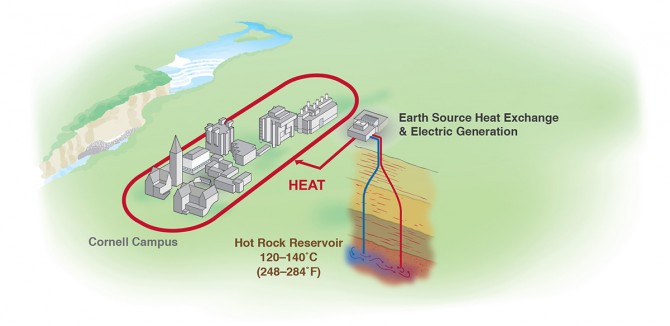Geothermal project could warm campus, expand energy study
By Syl Kacapyr
Cornell is calling the project “Earth Source Heat.” This effort to explore the potential of enhanced-geothermal energy will combine Cornell’s world-leading energy and sustainability researchers with the living laboratory of Cornell’s facilities over the next two decades. Its first step will be a planned small-scale demonstration installation within about five years of a well pair that will reach into the basement rock more than two miles below the surface to tap the Earth’s vast heat reservoir. Water will be circulated in a closed loop through the rock and return to the surface to supply heat to the campus.
Should this small-scale demonstration project prove successful, Cornell will consider moving forward with plans to install a full-scale system to heat most buildings on the campus. During extremely cold weather, the system would be supplemented with heat from a biomass gasification facility, providing a second source of clean energy. Using local biomass resources, such as wood or nonfood crops, would be more efficient than over-sizing the geothermal system to handle peak-heating loads.
This hybrid system would be the first in the U.S. to combine enhanced-geothermal with a district-heating system capable of distributing hot water from a centralized location to multiple buildings. Domestically, only a handful of enhanced-geothermal sites are under development – and all are currently focused on electricity generation.
The eastern U.S. has not been considered attractive for enhanced-geothermal projects because of its lower geothermal temperature gradients compared with the West. However, a recent survey of the upper Appalachian basin conducted by Cornell Engineering revealed that subsurface heat deep in portions of New York and Pennsylvania is likely of sufficient quality to provide district heating to residential and commercial buildings. This is especially significant given the Northeast’s cold winters and dense population centers.
Geothermal energy is being discussed by Cornell leadership as a possible way to help meet ambitious net carbon emission reduction goals laid out in the university’s Climate Action Plan in 2009. Since that time, Cornell has reduced its emissions by more than 30 percent through several initiatives, including the construction of solar farms and the decommissioning of its coal-powered energy plant. Cornell is pursuing the Earth Source Heat project to eliminate up to an additional 38 percent of its emissions.
“Few institutions are as well positioned to demonstrate this advanced geothermal system as Cornell, which has leading faculty in all the relevant disciplines engaged in areas of research related to geothermal energy, combined with facilities engineers who are expert in deploying new technologies,” said Lance Collins, dean of Cornell Engineering and co-chair of the Senior Leaders Climate Action Group appointed by Cornell’s president to lead the drive for energy solutions on campus.
Cornell’s facilities also make it a unique candidate to deploy an enhanced-geothermal system.
“Our university’s ‘cogeneration’ combined heat and power plant currently pipes its excess heat via steam through campus using a district energy system. The system would have to be reconfigured to a hot-water system for enhanced-geothermal use,” said KyuJung Whang, vice president for infrastructure, properties and planning, and co-chair of the Senior Leaders Climate Action Group.
Cornell pursued a similarly ambitious project with its Lake Source Cooling system, which in July 2000 became one of the most significant energy initiatives to promote sustainability undertaken by an American university. The project established a system that pumps cold lake water through a heat exchanger to cool water circulated throughout campus. As a result, Cornell has seen an 86 percent reduction in energy use for campus cooling.
As it begins to explore Earth Source Heat, Cornell is engaging with community members and building a consortium of higher education, private business and government partners interested in helping move the project forward. The next steps will be to study, conceptually design, and develop technical and financial metrics for a small-scale demonstration project that would include a pair of wells, heat exchange facilities and interconnection for heating target areas of campus. After a full environmental assessment is completed, Cornell will develop a long-term process of continued community engagement to help determine the feasibility of developing a full-scale geothermal project.
The ultimate goal will be not just to significantly reduce carbon emission and create a new sustainable energy source at Cornell, but to advance new research and apply the lessons learned during Cornell’s Earth Source Heat project to create a new model for enhanced geothermal energy that can be scaled larger or smaller and applied around the world in areas long thought unsuitable for this carbon-free energy source.
And the impact of expanding this energy source in the United States alone could be sizable. According to a 2006 study chaired by Jeff Tester, director of the Energy Institute at Cornell and the Croll Professor of Sustainable Energy Systems in chemical and biomolecular engineering – and one of the faculty leaders of the Earth Source Heat effort – more than 100 gigawatts of electric capacity could be provided to the U.S. through enhanced-geothermal systems over the next 50 years. That represents 10 percent of the country’s overall electric capacity today. But to make enhanced-geothermal economically viable and to extend geothermal energy production beyond the western U.S., new enhanced geothermal district heating systems must be pioneered.
If Cornell’s Earth Source Heat project is successful, it could provide that much-needed blueprint that unleashes the potential of enhanced-geothermal energy.
Syl Kacapyr is public relations and content manager for the College of Engineering.
Editor’s note: The number of metric tons of carbon that would be eliminated annually if an enhanced geothermal energy project were proven feasible was updated Oct. 6; the original number was 82,000.
Media Contact
Get Cornell news delivered right to your inbox.
Subscribe